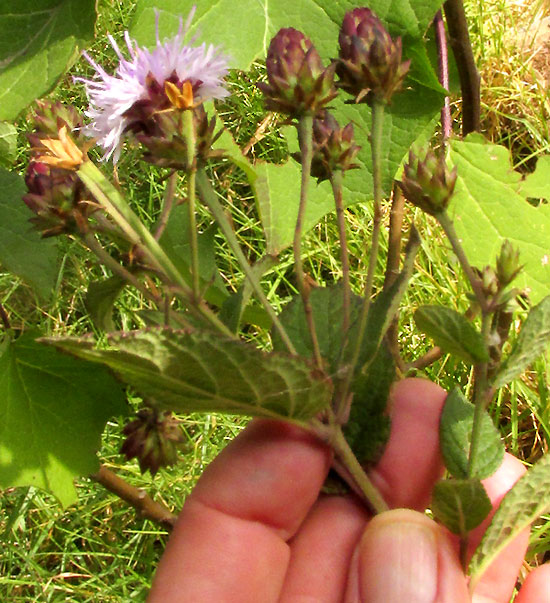Excerpts from Jim Conrad's
Naturalist Newsletter
entry from field notes dated January 19, 2023, taken in disturbed areas and along Hwy 120 on the north and east side of town, elevation ±2,380m (7600 ft); bedrock of Cretaceous limestone, in the Eastern Sierra Madre mountains; walking distance of Pinal de Amoles, Querétaro state, MÉXICO,(N21.137°, W99.622°)
IRONWEED

 Among weeds in an open spot beside a trail up the hill, the above wildflower, about a meter tall (1yd) didn't seem to notice the current drought. With numerous florets clustered into flower-like heads, it was clearly a member of the largest of flowering-plant families, the Composite, Aster or Sunflower Family, the Asteraceae. At the right it's seen that in the inflorescence the various heads, or capitula, arise on long peduncles.
Among weeds in an open spot beside a trail up the hill, the above wildflower, about a meter tall (1yd) didn't seem to notice the current drought. With numerous florets clustered into flower-like heads, it was clearly a member of the largest of flowering-plant families, the Composite, Aster or Sunflower Family, the Asteraceae. At the right it's seen that in the inflorescence the various heads, or capitula, arise on long peduncles.

Up close, the distinctive capitula were quite handsome. Notice that only cylindrical disc florets with long corolla lobs are present, with no ray florets. That single field mark disqualifies most of the Aster Family's 32,000 or so species in over 1900 currently recognized genera. The urn-shaped involucre composed of scale-like phyllaries also is distinctive. Its outer phyllaries are much shorter than the inner ones, and the lowest, shortest phyllaries tend to dry out and lose their dark purple color. The phyllary tips are spine-like.

A broken-open capitulum shows that atop the ovaries -- the future one-seeded, cypsela-type fruits -- there are long, white bristles comprising a pappus, which later will become the parachute helping the fruits to disperse. Also, a feature important for determining the genus is that between each floret in the capitulum there are no scale-like paleae.

The leaves are fairly distinctive, too, their surfaces being somewhat scratchy feeling, or scabrous, with veins a bit sunken below the blade surface (rugose). The margins are finely serrated, like saw teeth. Leaf blades arise from short petioles.
Because the Aster Family is so huge, all these details are necessary to notice. However, especially with its inflorescence gathered at the plant's top bearing purplish flowering heads, this plant is so similar to several common wildflower species in North America known as ironweeds, genus Vernonia, that already I had a hunch that that's what we had.
At this writing, Kew's Plants of the World Online database recognizes 344 species of ironweed mostly occurring in the Americas, Africa and southern Asia, but here and there elsewhere. In Mexico, according to Rosario Redonda-Martínez's 2017 publication "Diversidad y distribución de la trubu Vernonieae (Asteraceae) en México," if you accept the narrow interpretation of the genus, we have about 17 Vernonia species, more if you're of the old school. The 1995 (old school) Flora del Bajío, which includes our part of upland central Mexico, describes 16 species in our area.
Here in the Bajío region, if you a Vernonia with 8 or more florets per capitulum, the inflorescence is structured as on our plant and with capitulum peduncles up to 15 cm along, and the scaly involucre is taller than 13mm (like ours), you have the variable and readily hybridizing VERNONIA ALAMANII.
Vernonia alamanii, is an all-Mexican species, concentrated in the central uplands south to Oaxaca, with scattered occurrences toward the northwest, into Guanajuato. It inhabits various forest types at elevations between 1100 and 2600m (3600-8550ft).
The Flora del Bajío reports that the species is a good nectar producer, that livestock eat it, and that it's medicinal. The same words have been picked up by various websites, not saying what the species is medicinal for. Other ironweed species traditionally have been used for a broad spectrum of cures, and some species provide edible leaves. But hardly anything special is mentioned about Vernonia alamanii.